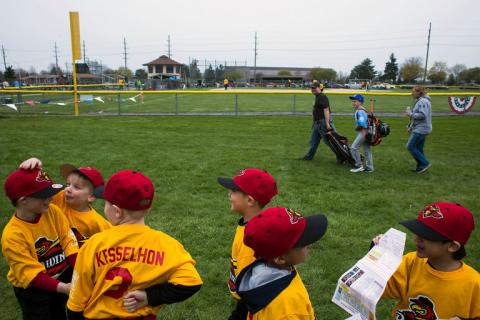Big Little League
New York Times
June 23, 2017
By Doug Glanville
Sure, there was a bat and a glove, but was it baseball? Then, one day, I looked up and realized that it actually was.
Keeping score is ingrained in my soul. Baseball is a game driven by outcomes — results interlocked in a quantifiable puzzle to predict the future, assess the past, even value the present — and I intimately lived that world professionally for almost 15 years. Yet now, having just coached another year of Little League, I question the conclusions we often make when coloring by numbers, especially when dealing with kids so young that unpredictable growth is inevitable.
I remember when I first watched my kids play sports. There was a basketball and a hoop, but it was not basketball. There was a bat and a glove, but it was not baseball. There was a soccer ball and a net, but it was not soccer. At least based on the rules I had come to understand. Maybe I felt that way because I saw one too many 4-year-olds napping at half court in the middle of a game or wandering off the field during a “breakaway” to report that their uniform was itchy or they needed Fritos.
I also came to the observer’s chair with the weight of having had a major league career. This tinted the lens, because I couldn’t help constantly assessing whether the kids had the requisite attitude and skills to suggest a possible professional sports future. Certainly, when it comes to baseball, I am qualified to notice anyone, no matter how young, who stands out.
But I’ve had to learn to keep my foot off that accelerator so I don’t burden my kids or any other child. I am careful not to be the effusive dad in the stands yelling to his 5-year-old that he is pulling off the fastball, even if he actually is pulling off the fastball. I want my kids to enjoy the sport. I don’t want to make it a job before it even is a job. At times, it is hard to bite my tongue.
Of course, there are genuinely helpful parents (and other coaches) who shout advice all the time. I hear “elbow up” in my sleep at this point, and know that in hitting what really matters is getting into the right position at the right time. You could start in a handstand, but as long as you get to a good hitting position when it counts, you are golden. But with young kids, simpler is easier, and if that “elbow up” triggers what they need to do to get into position, then so be it. I just cannot recall ever hearing or thinking “elbow up” in all my years of pro ball, unless you were running over the catcher (which is no longer legal) or getting fitted for your uniform jersey.
So I often sit quietly, even though there is something about baseball that compels adults to fill in the frequent silences — a mix of holding on to the joystick of our child’s direction in life and of sheer nervous energy. I elect to cheer them on from the third-base coach’s box, reserving one-on-one whispers for personal instructions to the kids, trying to be supportive and positive, emphasizing the development of passion before professional mechanics.
Then, one day this season, I looked up and realized that what I was watching was actually baseball. Kids who are now 8 and 9 are throwing to bases, sliding, hitting live pitching, sending cutoff men to the outfield.
What happened?
Well, children grow, develop and learn at a much faster rate than adults do. So while I am repeating the same rules about, say, keeping your glove down, he or she is picking up nuances that even my major league pedigree can’t anticipate.
In my time as a pro, I saw an entire gamut of coaches. The firebrand, the pat-on-the-back guy, the manipulator, the motivational speaker, the psychologist, the tornado, the grin-and-bear-it guy. As a Little League coach, I’ve had to reflect on that diversity and think about who actually reached me in ways that stuck, that changed my heart, mind, soul and game.
Having an impressive big league résumé does not always translate into being an effective coach or a good communicator, and this holds true with Little League. No matter how many times I tell my kids the story of my Game 3 triple in the National League Championship Series against the Marlins, or how I got my 1,000th hit on the day their grandfather passed away, it’s not going to stop my son from trying to turn a ground ball back to the pitcher into an inside the park home run. Despite my efforts, as third base coach, to slow his advance by extending my arms in a stop sign the size of Connecticut the moment he got past first base. Apparently, he has to figure it out with empirical evidence, experience that sticks.
My daughter is on the same team as my son, and is nicknamed “bullet” for her speed. She is permanently, strategically crouched down to minimize her strike zone, and her walks turn into stealing every base humanly possible. She says she wants to “be like Jackie Robinson.” Yet through her eyes, I see a deeper concern about gender in our society. I wonder, how far can she go in this game? My son will probably benefit from baseball’s male heir legacy perks, but she deserves joy and a future, fairness and respect, just as my son does.
Their team has had a great season, knocking on the door of the finals but falling short after a three-way tie put them on the outside looking in. I have seen kids scared of the ball now hitting line drives all over the place. I have seen kids who were unable to catch the ball a month ago learn not only how to catch the ball, but also how to tag a runner out. And then there is me, the father, proud of his son growing as a hitter and his daughter loving her chance to run the bases with the wind.
And I have learned from these kids. Most of which has nothing to do with anything that one can count or quantify. When a pitcher hit one of our batters, she went to the mound to accept his apology with a handshake and a smile. The handshakes continue after the final score is tallied, even after a hard-fought playoff game, where both teams show sportsmanship, mano a mano, face to face.
Where does that go when we put on the big league uniform?
My kids are young. They are slowly headed in their own directions, and I hope they are carrying the best of us with them, parts that are more than just bat speed and velocity, but confidence, sportsmanship, love, respect, history, honor … the critical intangibles of life. And it is all underscored by my joy at seeing them find joy. As time marches on, and the stakes get higher and the heartbreaks bigger, any parent must admit that sometimes we will want to step back and reclaim that time when there was a 4-year-old sleeping at half court.
Republished from The New York Times
Photo: A Little League T-Ball team before a game in Clinton Township, Mich.
Photo Credit: Brittany Greeson, The New York Times






